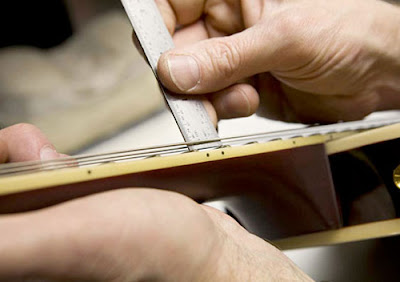A Formidable Challenge:
Side Reconstruction on a Taylor 814c
(Click images for larger view.)
by Ryan Elewaut
A
customer in Sedona emailed me out of the blue last year. He
included an eBay link and asked my opinion, "Is this fixable?" He
wanted to buy this guitar,
but only if it could be restored-- and he needed a fairly solid quote
to gauge whether or not this was a good investment. I looked carefully
at all the pics posted on the eBay auction, and pondered for awhile.

This was not an easy estimate. I
thought through the procedure with only these pictures to guide me, and proposed an estimate. The customer and I decided yes, it was worth it and I was up for the challenge.
My estimate was reasonable enough to allow the customer to cross his
fingers and buy the guitar online, knowing the investment in the repair
would still net him a great value for such an instrument. Keep in mind,
this expensive guitar was flawless and like new, except for the huge broken hole at the cutaway.

 The story was that someone had bought this guitar in about 2007 and shortly thereafter, dropped a dumbbell on the cutaway area, straight down on the side. The guitar was then put in a closet and forgotten about. I imagine the sickening feeling in the original owner's stomach lead him to simply hide the reminder of such a tragedy.
The story was that someone had bought this guitar in about 2007 and shortly thereafter, dropped a dumbbell on the cutaway area, straight down on the side. The guitar was then put in a closet and forgotten about. I imagine the sickening feeling in the original owner's stomach lead him to simply hide the reminder of such a tragedy.
The customer who bought it on eBay after consulting with me had it shipped directly to the shop. It quickly became one of those jobs you put on the bench just to stare at it for long periods of time- multiple times- before the work even begins. I already had a general
idea about the approach from the pics, but now I had to really detail
the procedure in my mind before starting; there were so many different breaks and cracks, inside and out, including internal bracing and top and back seams.
It was also nice to find some
of the puzzle pieces rattling around inside the guitar. I decided to
glue most of the fracture with CA glue (cyanoacrylate, high grade super glue,) which has the advantage of drying fast and buffing like lacquer. The CA glue can also be used to topcoat an area, like a finish.
I was able to gently force the wood back into place as I glued
different parts, attempting to do so in the opposite order from how it
compressed and fractured. I also used standard
wood glue for a few areas, such as the back/side separation at the
binding, and the internal reinforcement.
I knew before starting that the
inside would need to be reinforced-- I just wasn't sure of the best way to go about it. After
slowly piecing everything back together,
light could be seen passing through the cracked area. I
found black burlap material at the fabric store, saturated it in wood
glue, and then pasted it inside of the cutaway area. This was
done twice, creating two rigid layers to protect the fragile area. Any
and all pin- holes were filled and buffed, and made invisible by the
dark burlap cast inside.
After
a lot of fine sanding, scraping, and buffing, the finished job looked
excellent. The customer and myself were both surprised and pleased by
the result.
I set it up with a compensated bone saddle and installed an L.R. Baggs Anthem acoustic pickup system as well. It sounded absolutely amazing and played the same. I was very happy to bring this guitar back to life. 
Hey! It's almost like a new 814ce now, but for half the price when all was said an done!





















